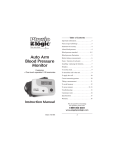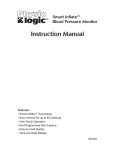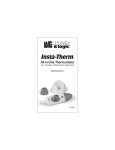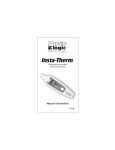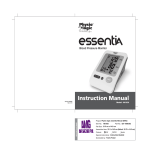Download AMG Medical Physio logic Instruction manual
Transcript
® Automatic Wrist Blood Pressure Monitor with Smart Valve Technology Instruction Manual Features: • Smart Valve Technology • Memory for up to 90 Readings • 3-Reading Averaging • Time and Date Display • One-Touch Operation • Easy-to-read Display • Auto Shut-Off • BP Manager Software • USB Data Transfer to PC 106-975 Table of Contents Smart valve measuring technology. . . . . . . . . . . . . . . . . . . . . . . 3 Statement of accuracy . . . . . . . . . . . . . . . . . . . . . . . . . . . . . . . . . 3 About blood pressure . . . . . . . . . . . . . . . . . . . . . . . . . . . . . . . . . 3 Blood pressure standard . . . . . . . . . . . . . . . . . . . . . . . . . . . . . . . 4 Blood pressure fluctuation . . . . . . . . . . . . . . . . . . . . . . . . . . . . . 4 Before taking a measurement . . . . . . . . . . . . . . . . . . . . . . . . . . . 5 Name / function of each part. . . . . . . . . . . . . . . . . . . . . . . . . . . . 6 Installing batteries. . . . . . . . . . . . . . . . . . . . . . . . . . . . . . . . . . . . 7 Carrying case . . . . . . . . . . . . . . . . . . . . . . . . . . . . . . . . . . . . . . . 7 Display explanation . . . . . . . . . . . . . . . . . . . . . . . . . . . . . . . . . . 8 Recalling memory. . . . . . . . . . . . . . . . . . . . . . . . . . . . . . . . . . . . 9 Clear values from memory . . . . . . . . . . . . . . . . . . . . . . . . . . . . . 9 Time adjustment . . . . . . . . . . . . . . . . . . . . . . . . . . . . . . . . . . . . 10 Applying the arm cuff . . . . . . . . . . . . . . . . . . . . . . . . . . . . . . . . 11 Correct measuring posture . . . . . . . . . . . . . . . . . . . . . . . . . . . . 11 Taking a measurement . . . . . . . . . . . . . . . . . . . . . . . . . . . . . . . 12 Troubleshooting . . . . . . . . . . . . . . . . . . . . . . . . . . . . . . . . . . . . 13 Cautionary notes . . . . . . . . . . . . . . . . . . . . . . . . . . . . . . . . . . . . 13 Data transfer to pc. . . . . . . . . . . . . . . . . . . . . . . . . . . . . . . . . . . 14 Blood pressure chart . . . . . . . . . . . . . . . . . . . . . . . . . . . . . . . . . 14 Specifications . . . . . . . . . . . . . . . . . . . . . . . . . . . . . . . . . . . . . . 15 2 Smart Valve Measuring Technology The Physio Logic® Smart Valve Wrist blood pressure monitor uses the oscillometric method to detect your blood pressure. Before the cuff starts inflating, the device will establish a baseline cuff pressure, which is equivalent to the air pressure. The measurement of your blood pressure is based on this baseline pressure. During the deflation of the wrist cuff, the monitor is detecting the pressure oscillations generated by the beat-to-beat pulsatile. After detecting the amplitude and the slope of the pressure oscillations during the deflation process, the monitor will determine the systolic and diastolic pressures for you, while your pulse rate is detected at the same time. Statement of Accuracy Blood pressure measurements determined with Physio Logic® are equivalent to those obtained by a trained observer using cuff / stethoscope auscultation method, within the limits prescribed by the American National Standard for Electronic or Automated Sphygmomanometers (ANSI / AAMI). About Blood Pressure Blood pressure is the pressure exerted on the arterial wall while blood flows through the arteries. The pressure measured when the heart contracts and sends blood out of the heart is systolic (highest). The pressure measured when the heart dilates with blood flowing back into the heart is called diastolic (lowest) blood pressure. High blood pressure’s strong correlation with cardiovascular diseases and high morbidity has made measuring blood pressure a necessity of identifying those at risk. 3 Blood Pressure Standard The World Health Organization (WHO) and the National High Blood Pressure Education Program Coordinating Committee have developed a blood pressure standard, in which areas of low and high risk blood pressure are identified. This standard is a guideline as blood pressure varies among different people and different age groups. It is important that you consult with your physician regularly. Your physician will tell you your normal blood pressure range as well as the point at which you will be considered at risk. Blood Pressure for Adults Age 18 and Older Category Systolic (mmHg) Stage 2 Hypertension Stage 1 Hypertension Prehypertension Normal ³ 160 140-159 120-139 < 120 Diastolic (mmHg) or or or and ³ 100 90-99 80-89 < 80 Blood Pressure Fluctuation Blood pressure fluctuates all the time! You should not be overly worried if you encounter two or three measurements at high levels. Blood pressure changes over the month and throughout the day. It is also influenced by season and temperature. 150 mmHg (Case: Male, 35 years old) 100 Systolic Diastolic 50 Wake up 6:00 Arrive office Telephone Argument Discussion in a meeting 18:00 12:00 4 Leave office Dinner / Sleep Midnight Before Taking a Measurement To help you obtain more accurate readings: • Urinate if necessary. • Remove any clothing and jewellery from your left arm. Placing the cuff on anything other than bare skin can result in an inaccurate reading. • Sit in a comfortable position with your legs and ankles uncrossed and your back supported. • Sit quietly for 15 minutes before measuring your blood pressure. • If you need to retake a reading, wait at least 5 minutes to allow your circulation to return to normal. • Pick a time of day, and take your blood pressure at about the same time every day. Since your blood pressure varies at different times of the day, this will make it easier for you to compare your daily blood pressure readings. A good time to take your blood pressure is in the morning, before breakfast. • Don't smoke, eat or exercise for 30 minutes before taking your blood pressure. These activities can change your blood pressure. • Do not measure your blood pressure immediately after consuming a large meal. To obtain more accurate readings, please wait one hour before measuring. • Only take your blood pressure in a quiet place and when you are relaxed. Don't take your blood pressure when you are under stress. Any stress will raise your blood pressure. • Position your arm so that the cuff is at the level of your heart. • If the monitor is stored at very low temperature (near freezing), place it in a warm location for at least one hour before using it. 5 Name / Function of Each Part Date/Time Set key LCD display Battery cover Memory Recall key Wrist Cuff Start/Stop key 2 “AAA” size, 1.5 V Alkaline batteries 6 Installing Batteries 1. Place your thumb on the side of the battery cover. Pull the battery cover in the direction of the cuff to open. 2. Install lower battery first in the bottom position with the battery ribbon underneath. Ensure correct polarity. Battery Type: 2 Alkaline LR03 (AAA) size. Place in the other battery and pull up the battery ribbon over it. 3. Replace the cover by placing the end tabs of the battery cover in the slots on the top of the battery compartment. Click in the other end to secure the battery cover. Replace batteries when: 1. Low battery icon appears on display. 2. Nothing appears in the display when the power is switched on. Note: Remove batteries when unit is not in use for extended periods of time. Batteries are hazardous waste. Do not dispose them together with the household garbage. Carrying Case Please store your blood pressure monitor in the carrying case as shown below. 7 Display Explanation Date / Time indicator Systolic pressure Diastolic pressure Pulse rate No. of memory sequence Shows the number of stored measurements. Pulse Mark: Shows the pulse rate per minute. Appears when batteries should be replaced. Measurement Error (user’s pressure exceeding 250 mmHg or lower than 40 mmHg): Measure again quietly. Keep wrist and arm steady during measurement. If error keeps occurring, see page 13 - Troubleshooting. Air Circuit Abnormality: Measure again. Pressure Exceeding 300 mmHg: Measure again. Data Error: Remove and reload the batteries. 8 Recalling Memory 1. To read memory values, press the "M" key. The memory values will be shown on the LCD display. The average measurement will be shown first and a new press of the “M” key will show the last measurement. 2. Every new press of the “M” key calls for one prior value stored. Clear Values from Memory 1. Press and hold the “M” key for approximately 5 seconds to clear the data. The data may be lost if the batteries are removed. Users should record the data on a blood pressure recording chart or in the BP Manager before removing the batteries. 9 Time Adjustment 1. To adjust the date / time in the monitor, press the Set key . The display will show a blinking number showing the month. 2. Change the month by pressing the “ ” Key. Each press will increase the number by one in a cycling manner. Press the Set Key again to confirm the entry, and the screen will show a blinking number representing the date. 3. Change the date, the hour, and the minute as described in Step 2 above, using the “ ” Key to change and the Set Key to confirm the entries. 4. A “0” will reappear as the Blood Pressure Monitor is ready for measurement again. Press the Set key blinking month increasing month confirm the entry 10 Applying the Arm Cuff 1. Remove all watches, jewellery, etc. prior to attaching the wrist monitor. Clothing sleeves should be rolled up and the cuff should be wrapped on bare skin for correct measurements. 2. Apply cuff to the left wrist with the palm facing up as in Figure A. 3. Make sure the edge of the cuff is about 1 cm from the palm as in Figure B. 4. Fasten the velcro strap securely around your wrist so there is no extra space between the cuff and the wrist as in Figure C. If the cuff is not wrapped snugly enough (snug, not tight), the measurement will be false. 5. If your physician has diagnosed you with poor circulation in your left arm, carefully place the cuff around your right wrist as shown in Fig. D. Fig. A Fig. B Fig. C Fig. D Correct Measuring Posture 1. Place your elbow on a table so that the cuff is at the same level as your heart. 2. If the cuff is not at the same level as your heart, use a soft object such as a folded towel to support your forearm in a horizontal position. 3. Turn your palm upwards, sit upright in a chair, and take 5-6 deep breaths. Avoid leaning back. 11 (X) Taking a Measurement 1. Wrap the cuff on the wrist. Press the START key. All digits will light up checking the display functions (see fig.1). This will take approximately 2 seconds. 2. After all the symbols appear, the display will show a “0” (see fig.2). The monitor is now ready to measure. 3. Once the monitor inflates the cuff to approximately 180 mmHg, the measurement will begin (see fig.3). 4. When the measurement is completed, systolic, diastolic and pulse will show simultaneously on the LCD screen (see fig.4) and be saved automatically in the memory system. A maximum of 90 measurements can be saved in the unit’s memory . Note: The monitor will re-inflate automatically to approximately 220 mmHg if the system detects that it needs more pressure to do a measure. Notes: This monitor automatically switches off approximately 60 seconds after last key operation. To interrupt the measurement, simply press any key. The cuff will deflate immediately after any key is pressed. During the measurement, do not talk or move your arm or hand muscles. Fig. 1 Fig. 2 Fig. 3 Fig. 4 12 Troubleshooting Symptom: No display when the START button is pressed. Correction: If the batteries have run down, replace them with new alkaline batteries. If the batteries are not in the correct position, re-insert them with the correct polarities. Symptom: EE mark shown on display or the blood pressure value is displayed excessively low (high). Correction: Wrap the cuff properly so that it is positioned correctly. If you talked or moved during the measurement, measure it again quietly. If the wrist was shaken during the measurement, repeat measurement. Always wait at least 5 minutes before taking another measurement. Note: If the unit does not work, please call our consumer information line at 1-800-363-2381. Under no circumstance should you disassemble the unit and attempt repairs. Cautionary Notes 1. Avoid extreme temperatures, humidity, and direct sunlight. Avoid strongly shocking the main unit, and protect it from dust. 2. Clean the blood pressure monitor body and the cuff carefully with a slightly damp, soft cloth. Do not press. Do not wash the cuff or use chemical cleaner. 3. Do not press the Start key when the cuff is not on the wrist. 4. Remove the batteries when the unit is not used for a long time. 5. The unit should not be operated by children. 6. Do not disassemble the main unit or cuff. 7. This device might not be suitable for use by people with poor blood circulation, common arrhythmias, such as atrial or ventricular premature beats or atrial fibrillation. It is not designed for ambulatory use. 8. To stop operation at any time, press the Start key and the air in the cuff will be rapidly exhausted. 13 Data Transfer to PC Data transfer accessories: 1. Physio Logic® BP Manager software CD-Rom (PC compatible) Note: The BP Manager software must be used with Windows 2000 or XP operating systems. 2. USB cable. BP Manager software installation: Place the BP Manager CD-Rom in your computer’s CD-Rom drive and follow instructions on screen. If the installer does not start, double-click the CD-Rom icon, then double-click on “Setup.exe”. To upload data to the PC: 1. Turn on the computer, start the BP Manager software, and select a patient (user) file. Note: A patient file must exist prior to the data transfer. To create one, click on the “New” icon, enter the information, and click on “Save” (disk icon). 2. Turn off your BP Monitor. 3. Plug the round micro connector end of the USB cable in the BP Monitor and the other end in your computer’s USB outlet. 4. Turn your BP Monitor on. Its LCD screen will display a loop, indicating that it is ready for data transfer. 5. In the BP Manager software, click on “connect” (PC link icon) to start the data transfer. 6. Once transfer is complete, turn off your BP Monitor before unplugging the USB cable. Blood Pressure Chart For reliable monitoring and reference of blood pressure, keeping long-term records is recommended. Please download the Blood pressure chart (chart for recording and tracking crucial info : date, time, blood pressure) at www.amgphysiologic.com 14 Specifications Measurement method Measurement range : Oscillometric : Pressure: 40 to 250 mmHg ; Pulse: 40 to 199 beats / min. Pressure sensor : Semi conductor Accuracy : Pressure: ± 3 mmHg; Pulse: ± 5 % of reading Inflation : Pump driven Deflation : Automatic pressure release valve Memory : Up to 90 readings Auto-shut-off : 60 seconds after last button operation Operation temperature : 10°C to 40°C (50°F to 104°F) Operation humidity : 40 to 85 % RH maximum Storage temperature : -10°C to 60°C (14°F to 140°F) Storage humidity : 10 to 95 % RH maximum Power source : 3V DC, two LR03 1.5 V “AAA” batteries Dimensions : 79 (L) x 72 (W) x 71 (H) mm Weight : 130 g (G.W.) (without batteries) Wrist circumference : 13.5 to 22 cm (5.3” to 8.7”) Minimum age to use : 18 years old K.B. : Short time operation 2 minutes : Type BF Device and cuff are designed to provide special protection against electrical shocks. * Specifications are subject to change without notice. 15 Consumer Info-Line: 1-800-363-2381 AMG MEDICAL INC. 8505 Dalton, Montreal, QC H4T 1V5 www.amgphysiologic.com www.amgmedical.com 16 P/N 803-083 REV: 1.0 0205
















